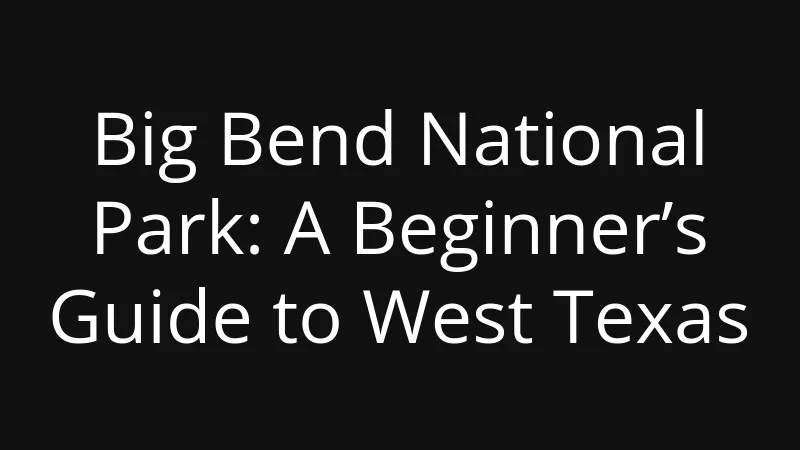Big Bend National Park: A Beginner’s Guide to West Texas Magic
Welcome to Texas, where everything is bigger—including the landscapes. If you’re planning a trip to the Lone Star State, you’ve likely heard of Austin’s music scene or Dallas’s skyline. But for the truly adventurous tourist, the crown jewel of Texas is a remote, vast, and breathtaking wilderness: Big Bend National Park.
This park is not a quick day trip. It’s a destination. As a first-time visitor, its sheer size can be overwhelming. This guide is designed to help you, the beginner, navigate the stunning beauty of West Texas with confidence.
Table of Contents
What Makes Big Bend So Special?
Big Bend isn’t just one park; it’s three parks in one. It’s the only national park in the United States that protects an entire mountain range, a massive swath of desert, and a spectacular river canyon system.
- The Chisos Mountains: The *only* mountain range in the U.S. contained entirely within a single national park. They rise dramatically from the desert floor, creating a cooler “sky island” ecosystem.
- The Chihuahuan Desert: This isn’t just flat sand. It’s a vibrant desert landscape filled with unique plants, fossils, and starkly beautiful geology.
- The Rio Grande River: This river carves a 118-mile boundary between the U.S. and Mexico, creating stunning, sheer-walled canyons like the famous Santa Elena Canyon.
This combination makes the park a hotspot for biodiversity, home to more species of birds, bats, and cacti than any other U.S. national park.
A Crucial Note on Travel: Getting There is Part of the Adventure
Let’s be perfectly clear: Big Bend National Park is remote. You cannot fly directly there, and it is far from any major Texas city. This is essential for planning your trip!
You *will* need a car, and you should fill up on gas whenever you see a station. Here are the approximate driving times from major Texas hubs:
| Starting City | Approx. Drive Time to Park HQ |
|---|---|
| El Paso, TX (Closest major airport) | 4.5 – 5 hours |
| Midland/Odessa, TX (Closest commercial airport) | 3 – 3.5 hours |
| San Antonio, TX | 5.5 – 6 hours |
| Austin, TX | 6 – 7 hours |
Pro Tip: Do not rely on your phone’s GPS or cell service. Download offline maps for the entire region before you leave your hotel.
Top 3 “Must-Do” Activities for Beginners
With limited time, focus on these iconic experiences.
1. The Santa Elena Canyon Trail
If you only do one thing, make it this. This easy 1.7-mile (round trip) trail takes you directly into the mouth of the towering Santa Elena Canyon, where the Rio Grande separates 1,500-foot cliffs. You may have to wade through a small amount of water at the beginning (depending on the river level), but the payoff is one of the most famous views in Texas.
2. The Chisos Basin Loop Trail
Escape the desert heat by driving up into the Chisos Mountains. The Basin is a natural “bowl” surrounded by peaks. The 1.8-mile Loop Trail is a perfect introduction to this unique mountain environment. It’s relatively easy and offers incredible views of the surrounding rock formations, like the iconic “Window.”
3. Ross Maxwell Scenic Drive
This 30-mile paved road is the best “highlights reel” of the park. It was designed for visitors, offering stunning overlooks of the Chihuahuan Desert and Chisos Mountains. The drive ends at the Santa Elena Canyon trailhead, making it a perfect two-for-one activity.
Essential Packing List: Safety & Comfort
This is not a regular city trip. What you pack is critical for your safety and enjoyment. Do not skip these items.
- Water, Water, and More Water: This is the most important item. The official recommendation is at least one gallon (4 liters) of water per person, per day. You cannot buy water in most of the park. Bring more than you think you need.
- Sun Protection: The sun is intense. Bring a wide-brimmed hat, high-SPF sunscreen, and UV-blocking sunglasses.
- Layers of Clothing: The desert has extreme temperature swings. A hot afternoon can turn into a very cold night, especially in the Chisos Mountains. Pack light, breathable shirts and a warm jacket.
- Sturdy Shoes: Leave the flip-flops at the hotel. You need hiking boots or sturdy sneakers, even for the easy trails.
- Offline Maps: As mentioned, your phone will not work in 99% of the park. A physical park map (you get one at the entrance) and offline digital maps are essential.
Where to Stay: Inside the Park vs. Nearby Towns
Because the park is so large, where you sleep matters. Your two main options are inside the park or in a nearby “ghost town.”
Inside the Park:
The Chisos Mountains Lodge is the only hotel inside the park. It’s centrally located but *books up many months, sometimes a year, in advance*. If you can get a reservation, do it. There are also three main campgrounds (Rio Grande Village, Chisos Basin, and Cottonwood).
Nearby Towns:
The closest towns are Terlingua and Study Butte (pronounced “Stoo-dee Byoot”). These are quirky, small “ghost towns” with a lot of character, offering motels, rental cabins, and unique restaurants. They are the best base for exploring the west side of the park (like Santa Elena Canyon). Marathon, to the north, is another, more upscale option.
A trip to Big Bend is a commitment, but it’s one that rewards you with solitude, dark skies perfect for stargazing, and some of the most dramatic landscapes in North America. It’s an unforgettable adventure for any Texas tourist.
